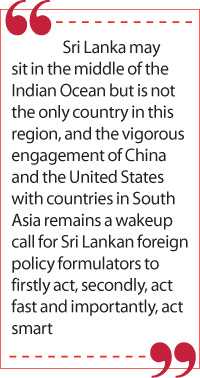Friday Dec 05, 2025
Friday Dec 05, 2025
Thursday, 29 October 2020 00:20 - - {{hitsCtrl.values.hits}}

The visit of US Secretary of State Michael R. Pompeo comes weeks after the visit of Chinese Foreign Minister Yang Jiechi earlier in October. The presence in Colombo of two of the leading diplomats of the world speaks volumes for Sri Lanka and the realisation of the growing importance of the country’s geographic positioning
Renewed international interest in Sri Lanka in recent months has coincided with the consolidation of the Quad, which brings together Australia, India, Japan and the United States of America; and with the resumption of China’s rise after the impediment the country faced with the outbreak of the pandemic. 
The remaining months of 2020 and the next couple of years remain crucial from both vantage points, but it is of importance for Sri Lanka at this stage to strategize foreign policy, avoid getting drawn into a much bigger game on the world stage, and quite crucially ensure that the developments are in favour of the island.
The visit of the US Secretary of State Michael R. Pompeo is a welcomed one. It comes weeks after the visit of the Chinese Foreign Minister Yang Jiechi earlier in October. The presence in Colombo of two of the leading diplomats of the world speaks volumes for Sri Lanka and the realisation of the growing importance of the country’s geographic positioning.
Sri Lanka’s potential
It was the American naval strategist, Admiral Alfred Thayer Mahan who once stated: “Whoever attains maritime supremacy in the Indian Ocean would be a prominent player on the international scene. Whoever controls the Indian Ocean dominates Asia. This Ocean is the key to the seven seas in the 21st century, the destiny of the world will be decided in these waters.”
As we surge into this century, the admiral’s vision is coming to fruition, and Sri Lanka, at the heart of the Indian Ocean, possesses immense potential, if only adequate strategising is applied to secure and bring to fruition Mahan’s observation, in Sri Lanka’s favour.
For too long, conquerors and capitals of foreign lands have realised the potential of the island, its resources and its waters. Yet domestic developments have mired the ability to comprehensively encapsulate everything that the country possesses and use it to the advantage of the island its people. Historic ties and the sound diplomacy have seen Sri Lanka making critical decisions in the realm of foreign policy that have often augured well.
China
In relation to China and the United States, Sri Lanka has maintained a diverse relationship. These are two countries at the forefront of leadership in the world in the 21st century, and two countries with which Sri Lanka has the possibility to interact constructively, if the correct policy formulation is adopted.
From the recognition of China in 1950 and the signing of the Rubber-Rice Pact in 1952, to the establishment of diplomatic relations in 1957 and beyond, Sri Lanka has continued to enjoy a close and cooperative relationship with China throughout the ensuing seven decade period.
In the last decade-and-a-half, Chinese infrastructure investment has augmented the development drive in Sri Lanka but it has come at a cost. Sri Lanka needed support and it was readily given. Faulting the giver, or encouraging those who do, is not the ideal. It is instead the responsibility of the receiver to ensure that that which was received was used in the most opportune manner, and not squandered away.
While China, as a matter of policy, does not interfere in the internal affairs of Sri Lanka or any country it deals with, the continuous support Sri Lanka has received, especially in the United Nations, remains paramount in the bilateral relationship.
 |
 |
United States
With the United States, seen today as the de-facto leader of the Quadrilateral Security Dialogue, the bilateral relationship with Sri Lanka has experienced moments in which the relationship has soared as during the visit of Vice President Nixon in 1953, the Jayewardene presidency, and the second Wickremesinghe premiership, and other times at which relations soured especially over pressure that was brought to bear on issues such as human rights. Yet despite the political variations, the economic and social engagement has remained a pillar of strength.
American missionaries were instrumental in establishing some of the leading schools in the country, American multinationals introduced prominent electronic brands into the country, and America has been at the forefront of trade ties with Sri Lanka.
The Annual Report of the Central Bank of Sri Lanka for 2019 indicates that the United States remains the single largest buyer of Sri Lankan exports, which increased to 26.3% from 25.9% in 2018. The US also remained the single largest garment export destination for Sri Lanka accounting for 45% of total garment exports in 2019. It is this relationship, these statistics and these opportunities that need to be nurtured and grown, for the US-Sri Lanka relationship to intensify.
US Deputy Assistant Secretary of State Thompson commenting, on the eve of the Secretary of State’s visit, that economic development options were being brought during the visit portends well for the bilateral relationship, and if delivered, would translate into positive news.
Sri Lanka has been looking to engage across the board and America expressing an interest of this nature is welcome as it hasn't been forthcoming in the recent past. Whilst the relationship with India and Australia remains sound, and that with Japan needs a further degree of emphasis, consolidating this US connection is vital for Sri Lanka at this juncture.
What Sri Lanka needs
Renewed American interest in the economic realm should ideally focus on investment and wider market access to generate tangible opportunities. This is exactly what Sri Lanka needs. A country that went through decades of conflict and experienced continuing international pressure has not been able to write its own narrative, but today the island is gradually inching towards that possibility. Sri Lanka needs concentrated interaction, well-nurtured ties and political will to realise the prospects of its geographic positioning.
Sri Lanka needs to be mindful of diverse engagement, with the leadership and diplomatic machinery handling this delicate process of interaction in the most effective manner, but it can be done. With the correct guidance and commitment it is possible for the country to regain its image and position in the international community, which was largely damaged by the conflict. Sri Lanka needs opportunities. If key players in the world are willing to provide them, they need to be skilfully negotiated and swiftly acted upon.
Whilst agreements are being touted as potential pre-requisites for such economic cooperation, there needs to be more openness and understanding. If a new policy or agreement is to be introduced it needs to be explained as clearly as possible.
Given that Sri Lanka is a democracy, and has remained so for decades now, there are varied voices and stances in society. It is this diversity, which is representative of any democracy that needs to be engaged with, and the United States understands this only too well. The need for such cross-sectional engagement is in itself a pre-requisite in any democratic environment, as is the need for transparency.
The last high level visit was in 2015 when Secretary John Kerry came months after the change of government in Sri Lanka that year, but it was a visit to express solidarity with the new administration and not precisely to provide any form of tangible support or enhance economic cooperation. At present, on the eve of a Presidential Election in the United States, there is renewed American interest not only in Sri Lanka but in a greater part of South and East Asia.
Political relations
In Sri Lanka's case, while the country is looking to gain investment and access to international markets, it is also hoped that enhanced economic ties would boost political relations. However the US is not only taking a keener interest in Sri Lanka, it is also looking at neighbours and hoping to increase the momentum of the US relationship with South Asia in general. This same narrative applies to China, which is looking to South Asia as an imperative aspect of its widening Belt and Road Initiative. This needs to remain a fundamental note from a Sri Lankan perspective.
Sri Lanka may sit in the middle of the Indian Ocean but is not the only country in this region, and the vigorous engagement of China and the United States with countries in South Asia remains a wakeup call for Sri Lankan foreign policy formulators to firstly act, secondly, act fast and importantly, act smart.